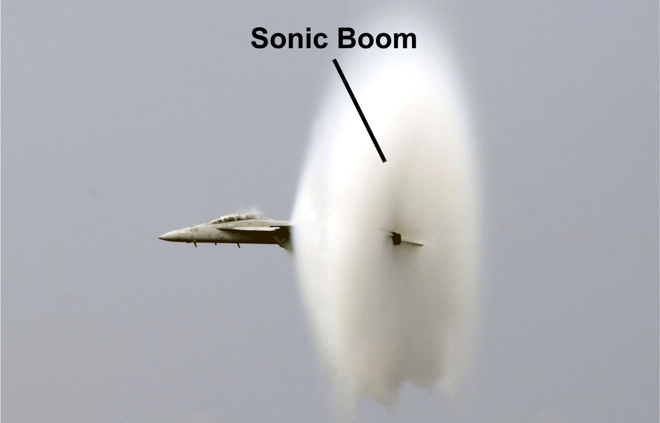What is Sonic Boom?
A sonic boom is a clangorous booming sound produced when an object, like an aircraft, passes over the speed limit. But what does it convey? To understand this, we must first comprehend the science behind this auditory miracle. And for that, it is vital to grasp the fundamental principles of sound and motion.
This piece delves into the science behind the sonic boom, exploring its causes, effects, and the fascinating role of the Doppler effect and shock waves in its creation.
The Basics: Understanding Sound and Motion
When a stone is dropped into a still pond, it produces waves that spread outward in concentric circles. Sound waves work on a similar principle as they radiate from their source. However, unlike waves on a two-dimensional pond surface, sound waves form three-dimensional concentric spheres.
The speed of these waves depends on several factors, including altitude and temperature, of the environment. For instance, sound travels at approximately 1225 km/h or 340.29 m/s at sea level. However, what happens when the source of sound is in motion?
The Doppler Effect: The Science of Changing Sound Frequencies
The Doppler effect, named after the Austrian physicist Christian Doppler, is a versatile concept that has discovered numerous applications. It explains the alteration in frequency and wavelength of a wave as observed by an individual in motion relative to the source of the wave. It occurs when there is a variance in velocity between the source of sound and the observer. This relative motion results in a shift in the wavelength and frequency of the wave, which can be observed in our daily lives. The Doppler shift is the actual frequency shift due to this relative motion, significantly impacting the source and observer. When the source and observer approach each other, the observed frequency increases and decreases as they move farther apart. The effect becomes more noticeable as the relative speed increases.
An intriguing outcome of the Doppler Effect is the occurrence of a Sonic Boom. This phenomenon arises when an object surpasses the speed of sound, resulting in a significant amount of constructive interference or a shock wave due to the accumulation of sound waves. Consider a moving sound source such as a train whistle. As the train moves in a specific direction, the sound waves in front of it bunch together, leading to a higher frequency. That is why an approaching train whistle sounds higher pitched than when it’s moving away. This change in frequency, or pitch, is known as the Doppler effect. However, as long as the speed of the sound source doesn’t exceed the speed of the sound waves themselves, these waves will remain nested within each other. The situation alters significantly when the object goes supersonic.
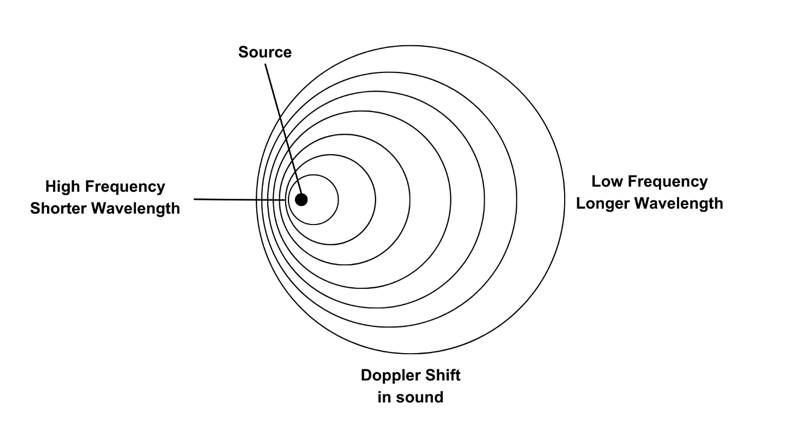
Mach Number and Shock Wave
The Mach number is a vital aspect in creating shock waves and sonic booms. Named after Austrian physicist Ernst Mach, this dimensionless number indicates the ratio of an object’s velocity to the speed of sound in a specific medium. While aircraft can travel at varying speeds in the air, the speed of sound remains constant in the atmosphere and is affected by altitude. In aeronautics, the ratio of the speed of sound to the aircraft’s velocity is known as the Mach Number, denoted by M. This ratio impacts the aerodynamic forces acting on the airplane.
Aircraft that travel at speeds significantly lower than the speed of sound are known as subsonic, with a value of Mach that is much less than 1. When aircraft fly close to the speed of sound, they are considered transonic, with Mach equal to 1. On the other hand, aircraft that move faster than the speed of sound fall under the supersonic category of aircraft, with M ranging from 1 to 3. If an aircraft’s speed exceeds Mach greater than 5, it is traveling at hypersonic speeds. As an airplane approaches Mach 1, the airflow over its wing accelerates to supersonic speeds, causing the formation of a shock wave on the wing. Once the aircraft surpasses Mach 1, a shock wave develops ahead of the wing’s leading edge. These shock waves are responsible for forming the audible sonic boom that we can hear.
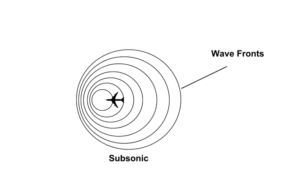
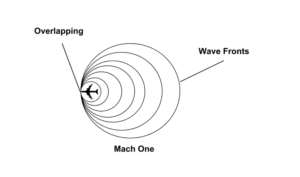
Sonic Booms and Shock Waves
In the aviation sector, a shock wave denotes a sudden and intense variation in pressure, temperature, and density in the air resulting from an object moving faster than the speed of sound or at supersonic velocities. This sudden alteration in the air’s properties leads to the formation of a forceful wave that is commonly associated with a sonic boom.
Shock waves are a necessary piece of a sonic boom. As an aircraft travels at supersonic speeds (faster than the speed of sound), it generates a pressure wave that moves through the air. This pressure wave is also known as a shock wave, which carries a significant amount of energy. It is responsible for creating the sonic boom.
Shock waves originate when an aircraft accelerates beyond the speed of sound. At subsonic speeds, air particles have sufficient time to flow out of the aircraft’s path, resulting in smooth and gradual pressure waves. However, as the aircraft’s speed approaches and surpasses the speed of sound, the air particles in front of it cannot adjust in time. This lack of “warning” leads to the rapid compression of air particles, forming a shock wave.
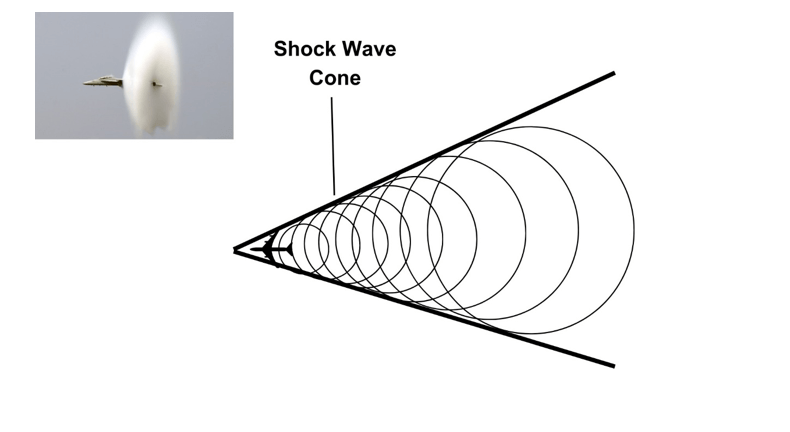
Breaking the Sound Barrier: Birth of a Sonic Boom
When an object, like an aircraft, surpasses the speed of sound, it surpasses the sound waves it produces, leaving them behind. As a result, new sound waves are produced, causing the original waves to combine and shape a distinctive cone known as a Mach cone. This compression of sound waves gives rise to a powerful shock wave, commonly known as a sonic boom.
It is important to note that sonic booms do not travel faster than the sound they produce, so you will not hear them when an object approaches them. Observers hear the sonic boom only after the object passes by. Pilots and passengers won’t be able to perceive the sonic boom as it surpasses the speed of sound, preventing the actual boom sound from reaching their ears. Consequently, the sound will forever remain distant from the aircraft, evading their auditory senses.
The Visual Phenomenon of Sonic Booms
It is fascinating to note that sonic booms go beyond being just audible occurrences. They can also generate a distinctive visual spectacle. The swift change in air pressure due to the aircraft’s high velocity causes a significant temperature drop in the atmosphere behind it. This rapid cooling leads to condensation and the formation of a visible cone-shaped structure, commonly known as a “Mach Cone.”
The Impact of Sonic Booms
Sonic booms have significant impacts and often produce problematic noises that can be distressing to people and animals on the ground. In some cases, it may even cause damage to the building. Therefore, it is necessary to understand the factors that affect sonic booms.
Factors Influencing Sonic Booms
Several factors can affect the impact and characteristics of a sonic boom. These include the aircraft’s altitude and flight path, air temperature, barometric pressure, and airplane specifications. For example, the higher an airplane flies, the greater the horizontal distance a sonic boom can reach.
The Future: Mitigating Sonic Booms
The quest to mitigate the effects of sonic booms is part of our ongoing journey to harness the power of speed. The race is on to make supersonic travel safer and more comfortable, whether by designing aircraft to minimize shock wave production or developing flight paths to reduce the impact on populated areas.
Summery
In summary, a sonic boom is a mysterious event that creates powerful shock waves when an object exceeds the speed of sound. Exploring the scientific principles behind sonic booms will not only enhance comprehension of high-speed travel complexities but also cultivate a greater appreciation for the beauty of sound and motion. As we strive to break speed barriers, the possibilities of uncovering more surprises in our quest for velocity are endless.

